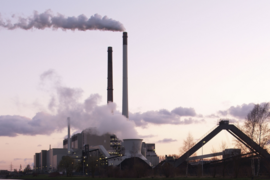Dispersal of mercury into the air has risen substantially since the industrial revolution, leading to increased mercury deposits in water and soil. Once there, it gets transformed by bacteria into methylmercury, a highly toxic form of the naturally-occurring heavy metal that can affect neurological and immune systems. Stored in the tissues of wildlife and humans, methylmercury concentrations are magnified with each step up the food chain. The mercury levels of a large predator fish such as trout, for example, may be more than one million times that of ambient water, potentially causing serious health consequences for human and wildlife consumers.
Much of the mercury pollution attributable to human activity is produced by coal-fired power plants and small-scale gold mining, with communities dependent on fishing and mining being among the hardest hit. In recent years, rising concerns about adverse consequences of mercury emissions have led to a number of new emissions-reduction policies. But just how effective are these policies?
For the past six years, MIT Joint Program research assistant Amanda Giang has been working to assess the environmental, public health, and economic impacts of mercury pollution and the efficacy of policies designed to reduce them. Toward that end, she has taken both a qualitative and quantitative approach. Drawing on input from stakeholders ranging from citizens in affected communities to domestic regulators and international negotiators, Giang has developed integrated assessment models that trace the path of mercury from emissions sources to polluted watersheds to impacted consumers. Using those models, she has estimated the amounts of future mercury emissions that various policies would likely avoid, and the environmental, health, and economic gains that would result.
Her ultimate goal is to use the models’ projections — and efforts to account for uncertainty in the data upon which they’re based — to empower local, regional, and global decision makers to design and monitor better policies to minimize impacts of mercury and other long-range, persistent pollutants.
Assessing effectiveness of mercury mitigation policies
With her goal in mind, Giang — who completed all requirements for a PhD in the Technology and Policy Program of the Institute for Data, Systems, and Society (IDSS) in May — has combined tools from atmospheric sciences, environmental and health economics, and other disciplines to advance a case study of global and regional mercury policy.
Her most salient findings appear in a paper co-authored by her advisor, Department of Earth, Atmospheric and Planetary Sciences Associate Professor Noelle E. Selin in the journal Proceedings of the National Academy of Sciences. The paper evaluates benefits to the U.S. of the United Nations Minimata Convention on Mercury, a global environmental treaty initiated in 2013 to significantly reduce mercury emissions. In collaboration with Selin, Giang developed an integrated framework that models chemical transport in the atmosphere; mercury exposure and health impacts; and economic impacts of the global Minimata Convention as well as of the domestic Mercury and Air Toxics Standard (MATS), which targets emissions from U.S. coal-fired power plants. The framework projected that by 2050, the U.S. is likely to benefit more than twice as much from the global policy than it will from the domestic policy, with one exception: MATS produces larger benefits for subsistence populations that depend on locally caught freshwater fish for much of their diet.
Giang cautions that the paper’s results, while providing a good handle on the impact of mercury emissions reduction policy, come with a fair degree of uncertainty. Sources of that uncertainty include how mercury-emissions policy will be implemented, the priorities of local stakeholders, how quickly emissions control technology will advance and clean energy technologies will be adopted, and where the global and regional climate are heading. These sources of uncertainty pose significant challenges for policy design, monitoring, and evaluation.
For her PhD dissertation, Giang worked to characterize and quantify different aspects of the uncertainty involved in mercury policymaking, with a focus on the Great Lakes region. Consulting with local stakeholders, she developed models to evaluate the environmental, public health, and economic impact of anthropogenic mercury emissions in the region, and the efficacy of regional and global policies designed to curb those emissions.
“This work comes at a critical time for mercury policy development, where decision makers need to figure out how to determine if policies are working,” Giang says. “The struggle isn’t just to get policy made but to make sure it’s effective at achieving its intended environmental and health goals. The Joint Program has been a great place to meet the latter challenge.”
A passion for environmental health and justice
Giang was exposed to environmental issues early in life (her elementary school song focused on sustainability), but by the time she became a freshman at the University of Toronto, her primary focus was on human health and ways to treat disease. It was as a biomedical engineering major that she found a way to combine these interests. Her first research experience, which involved the study of environmental contaminants, led her to shift her focus from disease treatment to prevention, and pay more attention to the environmental and social determinants of health. Meanwhile, courses in engineering and society impelled her to consider how environmental science could be used to empower communities to make better decisions about public health.
As she reached her senior year, Giang saw the MIT Technology and Policy Program as an ideal venue to explore how science-based policy can be designed to systematically protect environmental health and ensure environmental justice. Collaborating with Selin on mercury pollution policy studies provided the opportunity to address both concerns.
“Amanda’s research has given us a better, more detailed understanding of the links between policy decision making and mercury pollution,” Selin says. “In her work, she has been able to connect complex regulatory proposals to mercury emissions and transport, projecting impacts to communities. A unique aspect of her research has been her ability to mobilize methods from social science and engineering research to answer these questions. This research has been influential in helping policymakers to better understand the impacts and economic benefits of mercury regulations; for example, it has been cited by the EPA and in testimony before Congress.”
Giang’s research has also garnered numerous accolades, including the 2015 and 2016 Best Environmental Policy Paper awards for the journal Environmental Science and Technology, and best paper awards last year at both the Technology Management Policy Graduate Consortium in Cambridge, England, and the fall meeting of the American Geophysical Union.
Buoyed by her success at MIT, Giang plans to continue tackling environmental policy challenges for the foreseeable future. Her next step is to serve as a postdoc in Selin’s group and as a visiting fellow at Harvard University’s Program on Science, Technology and Society. In January she will begin work as an assistant professor at the University of British Columbia in Vancouver.
“My hope is to continue exploring questions of policymaking under uncertainty, and how communities can be more involved in policy design and evaluation,” she says. “Thinking about how we proceed in the face of uncertainty involves not only a deep understanding of natural and social systems, but also value judgments, and so it’s important to include both expert analysis and public deliberation.”
Giang’s research has been funded by the National Science Foundation, the Natural Sciences and Engineering Research Council of Canada, and the MIT Martin Family Society of Fellows for Sustainability program.
This article originally appeared in the Spring 2017 issue of Global Changes, a biannual publication of the MIT Joint Program on the Science and Policy of Global Change.










